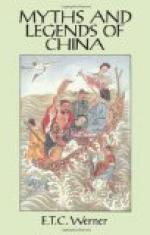Shen I, on returning to his solar kingdom, built a wonderful palace, which he called the Palace of the Lonely Park.
From that time the sun and moon each had their ruling sovereign. This regime dates from the forty-ninth year (2309 B.C.) of Yao’s reign.
When the old Emperor was informed that Shen I and his wife had both gone up to Heaven he was much grieved to lose the man who had rendered him such valuable service, and bestowed upon him the posthumous title of Tsung Pu, ‘Governor of Countries.’ In the representations of this god and goddess the former is shown holding the sun, the latter the moon. The Chinese add the sequel that Heng O became changed into a toad, whose outline is traceable on the moon’s surface.
Star-worship
The star-deities are adored by parents on behalf of their children; they control courtship and marriage, bring prosperity or adversity in business, send pestilence and war, regulate rainfall and drought, and command angels and demons; so every event in life is determined by the ‘star-ruler’ who at that time from the shining firmament manages the destinies of men and nations. The worship is performed in the native homes either by astrologers engaged for that purpose or by Taoist priests. In times of sickness, ten paper star-gods are arranged, five good on one side and five bad on the other; a feast is placed before them, and it is supposed that when the bad have eaten enough they will take their flight to the south-west; the propitiation of the good star-gods is in the hope that they will expel the evil stars, and happiness thus be obtained.
The practical effect of this worship is seen in the following examples taken from the Chinese list of one hundred and twenty-nine lucky and unlucky stars, which, with the sixty cycle-stars and the twenty-eight constellations, besides a vast multitude of others, make up the celestial galaxy worshipped by China’s millions: the Orphan Star enables a woman to become a man; the Star of Pleasure decides on betrothals, binding the feet of those destined to be lovers with silver cords; the Bonepiercing Star produces rheumatism; the Morning Star, if not worshipped, kills the father or mother during the year; the Balustrade Star promotes lawsuits; the Three-corpse Star controls suicide, the Peach-blossom Star lunacy; and so on.




